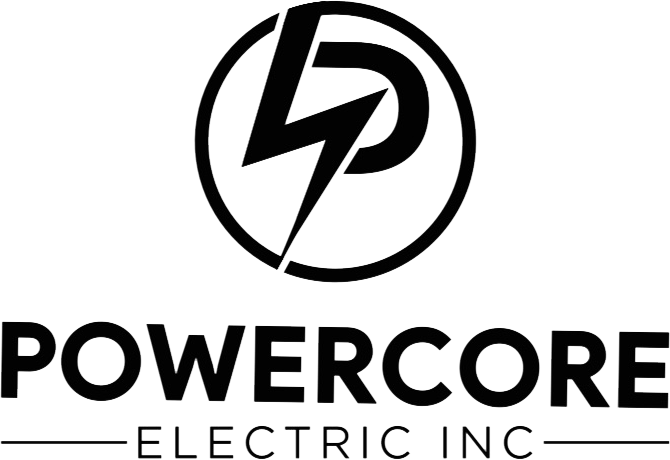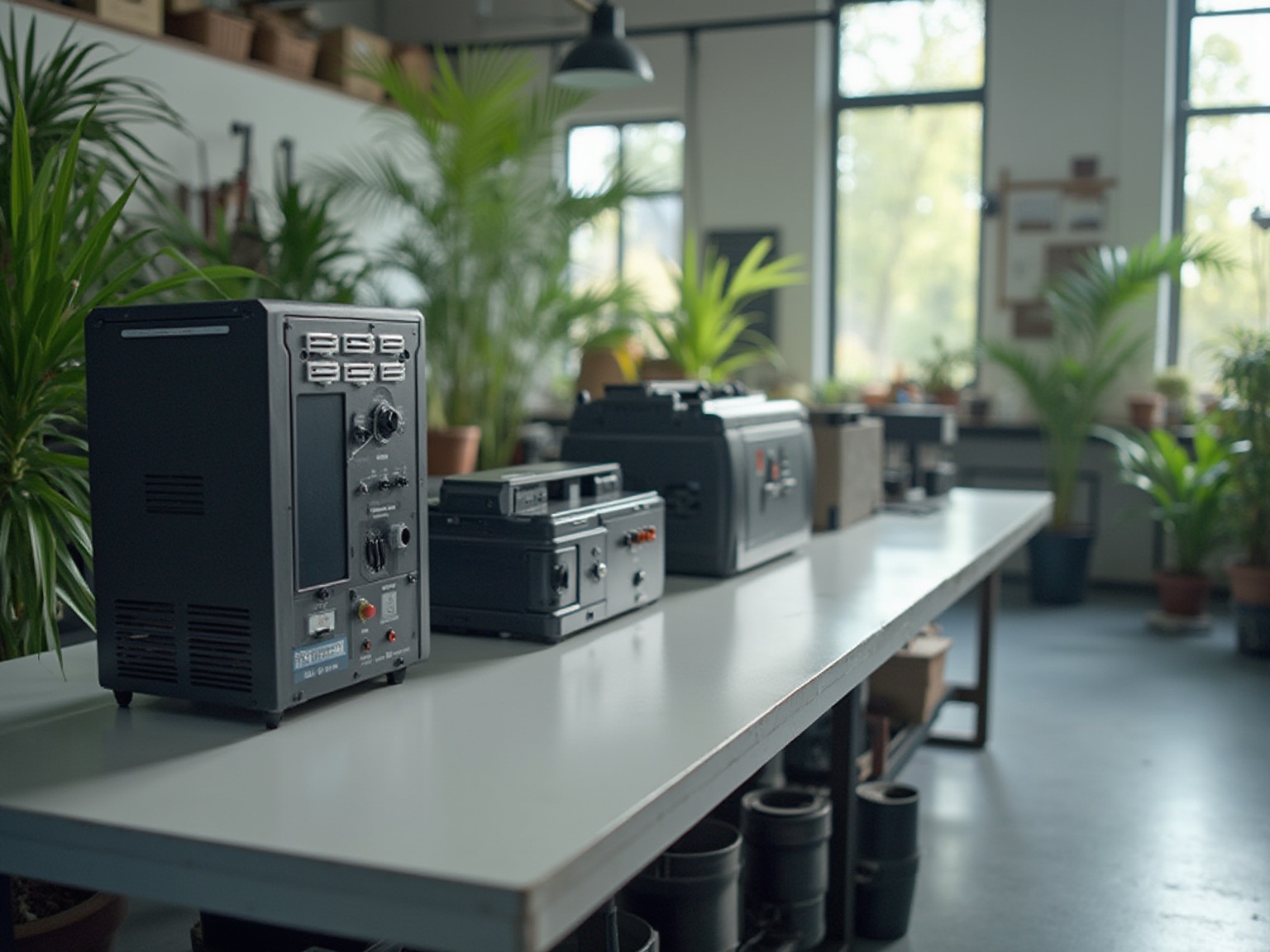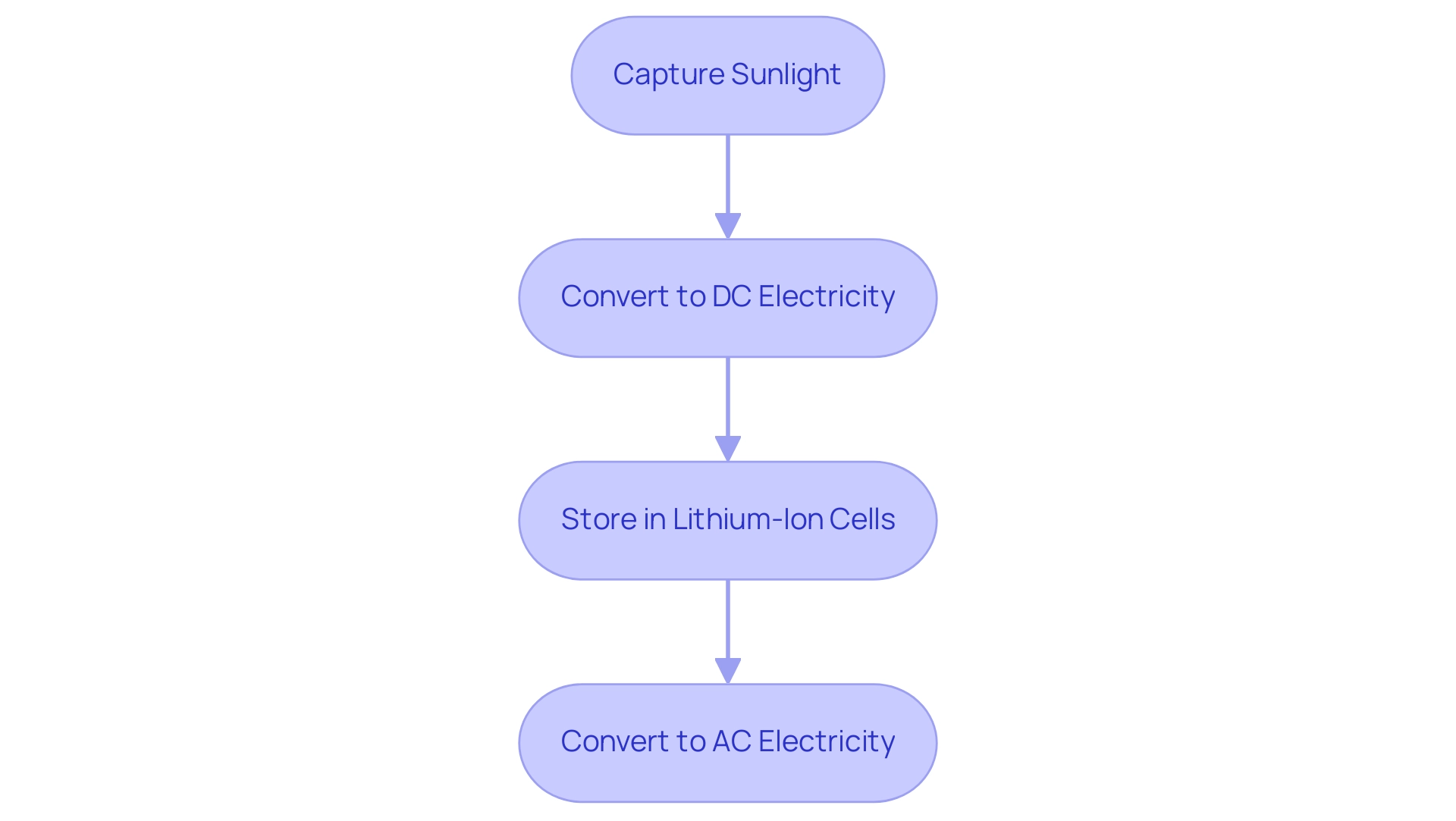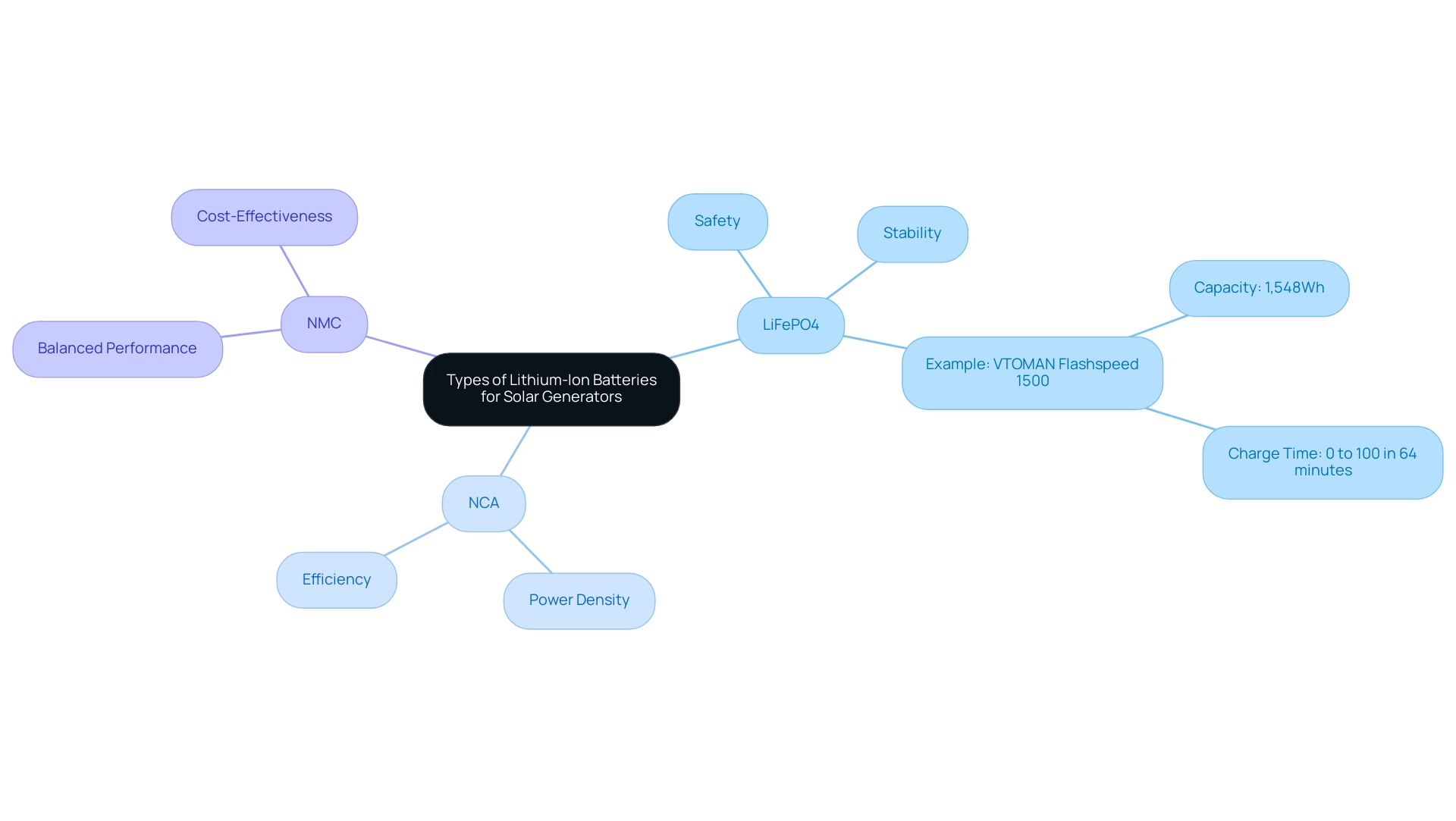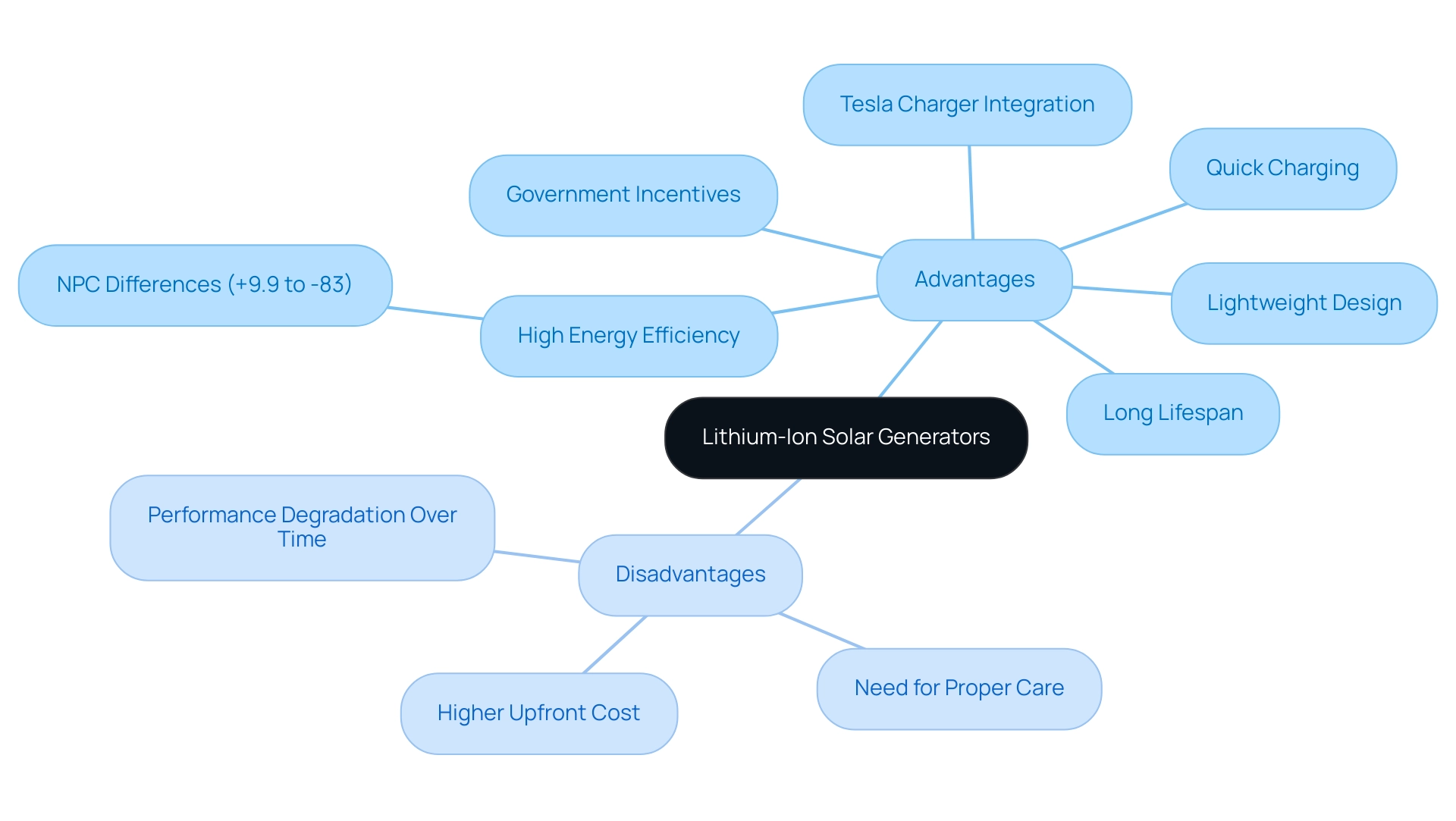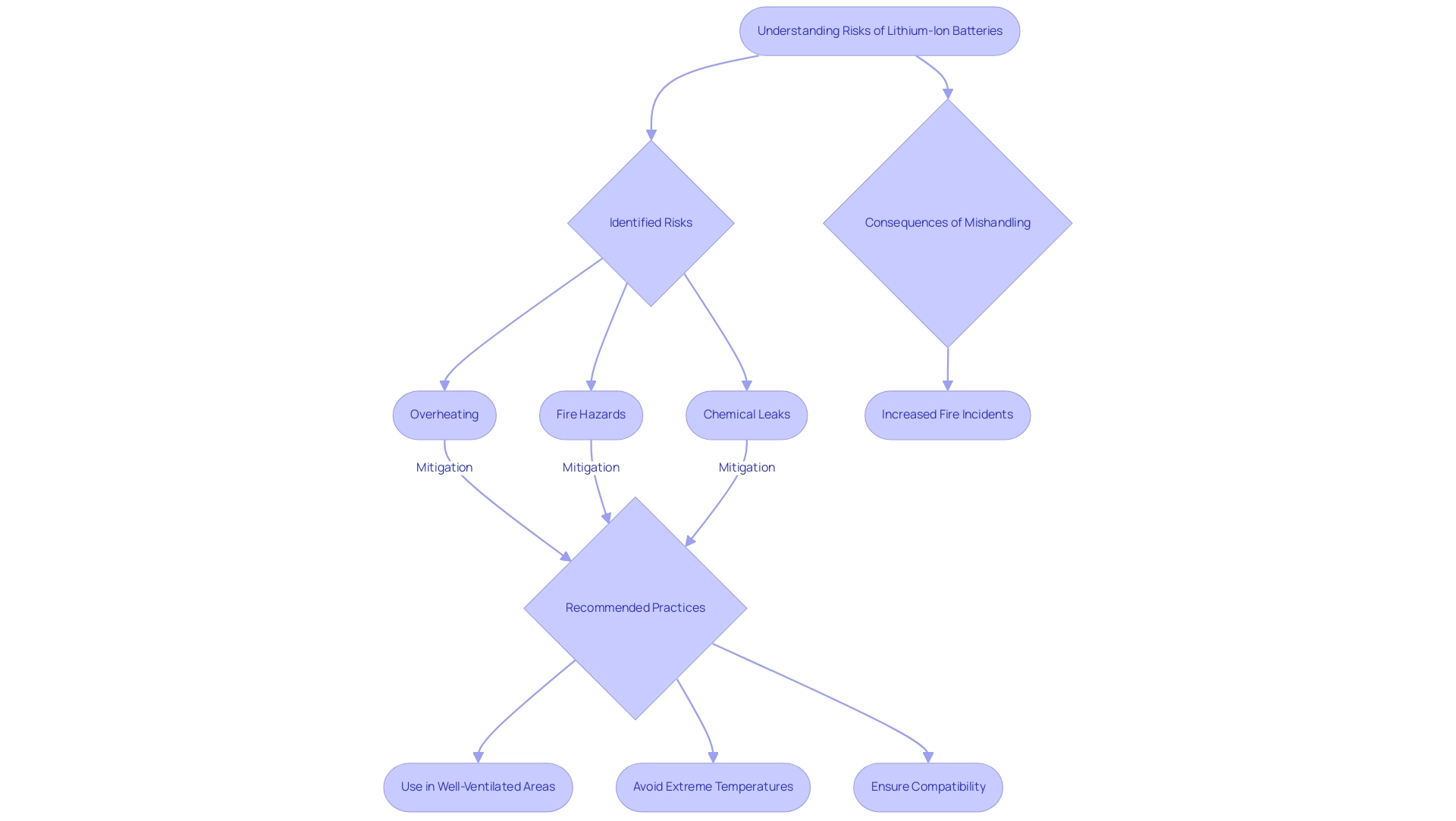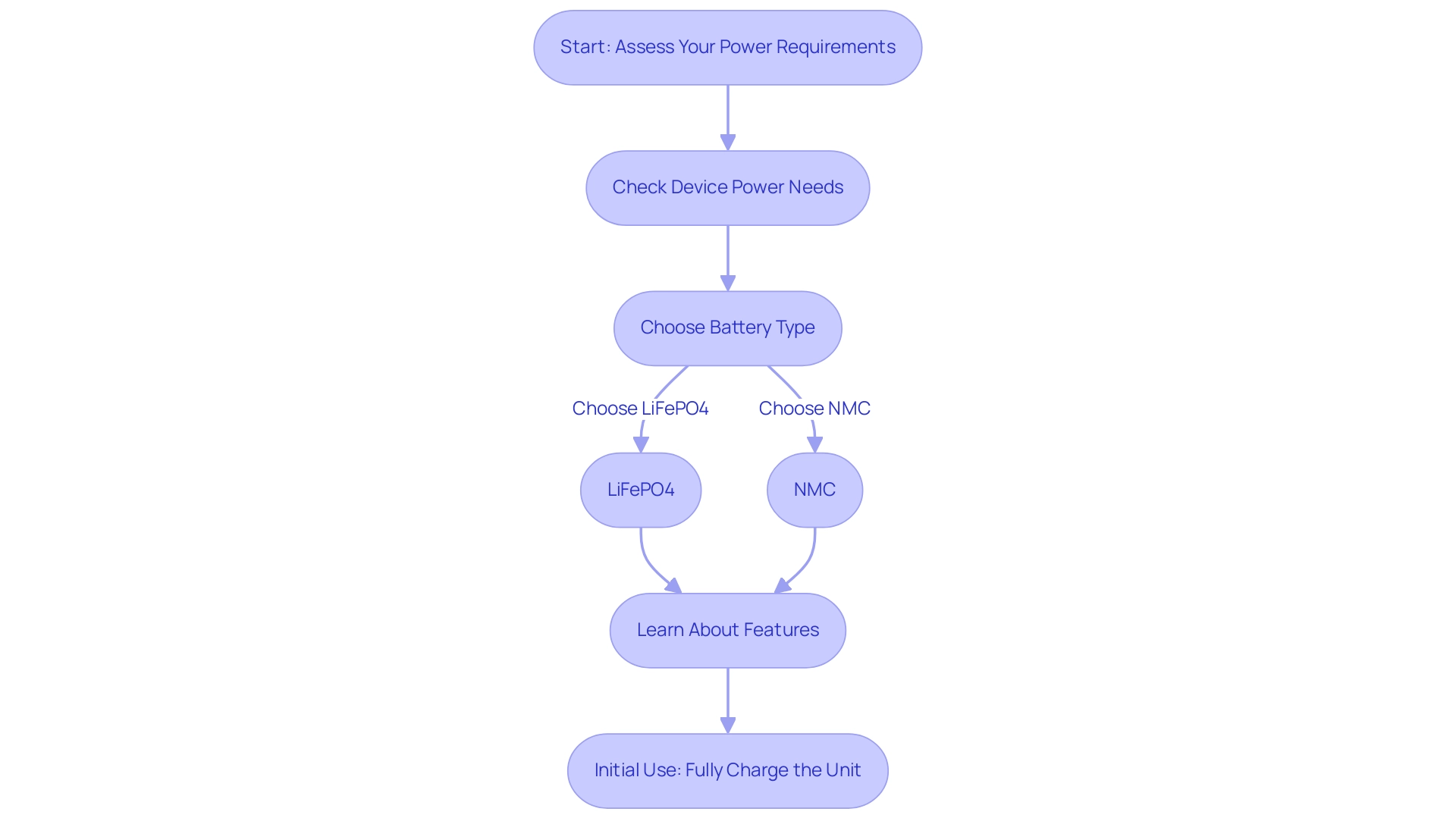Overview
Lithium-ion solar generators are efficient portable power sources that convert sunlight into electricity, making them ideal for off-grid living and emergency backup. The article emphasizes their advantages, such as longevity and quick charging, while also addressing challenges like higher initial costs and safety considerations, ultimately guiding beginners in selecting the right generator based on their specific energy needs.
Introduction
In the quest for sustainable energy solutions, lithium-ion solar generators have emerged as a game-changer for homeowners seeking reliable, portable power. These innovative devices not only convert sunlight into electricity but also store it efficiently for use whenever needed—be it during a camping trip, a power outage, or for everyday off-grid living.
As technology advances, the market is witnessing a surge in options, with newer models offering impressive capabilities to meet diverse energy demands. However, with great power comes the need for informed choices. Understanding the various types of lithium-ion batteries, their pros and cons, and essential safety considerations is crucial for making the right investment.
This article delves into everything homeowners need to know about lithium-ion solar generators, from their functionality to practical tips for choosing the best fit for their needs. Whether exploring the latest innovations or weighing the benefits of different battery types, this guide aims to illuminate the path toward sustainable energy solutions for every household.
Introduction to Lithium-Ion Solar Generators: Basics and Functionality
Lithium ion solar generators serve as your go-to portable power sources, effortlessly converting sunlight into electricity using solar panels. These convenient gadgets powered by a lithium ion solar generator retain power in lithium-ion cells, making them ideal for off-grid living, emergency backup, or even your next camping trip. Here’s how they work: Solar panels capture sunlight and transform it into direct current (DC) electricity.
This power is then kept in the cell, prepared for when you require it. When it’s time to power your devices, the stored power gets converted back into alternating current (AC) electricity, which is what most appliances use. Thanks to the efficiency and durability of lithium-ion batteries, the lithium ion solar generator offers dependable energy solutions for a wide array of needs, ensuring you’re always ready, regardless of the circumstance.
However, it’s important to consider the challenges in the renewable energy market. As emphasized by recent insights, including the introduction of the Jackery Explorer 2000 Plus, which can power devices up to 6000W, technology is progressing to tackle challenges such as high expenses compared to conventional gas-powered systems and efficiency issues during overcast conditions. Moreover, with consumption trends indicating a 1% decline in the United States, more homeowners may find solar generators appealing as sustainable backup power solutions.
When comparing types of power sources, lithium ion solar generators stand out for their longevity and efficiency, while lead-acid options are generally more affordable but have a shorter lifespan and lower power density. Flow cells, though not as prevalent, provide benefits in scalability and long-duration power storage. For homeowners looking for the top energy storage options, choices such as the Tesla Powerwall and LG Chem RESU are strongly advised because of their efficiency and dependability, making them appropriate for diverse energy requirements.
Exploring Different Types of Lithium-Ion Batteries for Solar Generators
When it comes to solar generators, you’ll discover a few exceptional types of lithium ion solar generators that can power your home sustainably. Let’s break down the three main players:
- Lithium Iron Phosphate (LiFePO4)
- Lithium Nickel Cobalt Aluminum Oxide (NCA)
- Lithium Nickel Manganese Cobalt Oxide (NMC)
LiFePO4 cells are often hailed as the gold standard for home applications due to their exceptional safety and stability. They’re designed to last, making them a favorite among eco-conscious homeowners. For instance, the VTOMAN Flashspeed 1500, which features a capacity of 1,548 and charges from 0 to 100% in just 64 minutes, exemplifies the efficiency and reliability of LiFePO4 technology.
Conversely, NCA cells are recognized for their remarkable power density and efficiency—perfect if you seek maximum strength in a compact form. Finally, we have NMC batteries, which strike a balance between power density and cost, providing an excellent choice for those seeking to maximize value without compromising on performance.
In the broader context of renewable solutions, understanding how these batteries interact with photovoltaic panels can guide your decisions. For example, Tesla home chargers are designed to work seamlessly with renewable energy systems, allowing homeowners to charge their electric vehicles using clean energy. Furthermore, government initiatives focused on encouraging panel installation can offer financial incentives that make incorporating these technologies more affordable.
Choosing the appropriate power source, like a lithium ion solar generator, truly relies on your particular requirements and how you intend to utilize your generator. Whether you prioritize safety with LiFePO4, power density with NCA, or a balanced approach with NMC, there’s a type available that’s perfect for your home. As quoted by EcoFlow, even if it does carry a hefty price tag (currently on sale for $391, down from $999), their model hits a sweet spot of basic functionality, capacity, and price.
With recent advancements in Lithium Iron Phosphate technology, staying informed will help you make the best decision for your backup power solutions. The VTOMAN Flashspeed 1500’s impressive capabilities in charging speed further enhances the conversation on power types and their uses, ensuring you can enjoy the advantages of sunlight in your home.
Pros and Cons of Lithium-Ion Solar Generators: What You Need to Know
Lithium ion solar generators offer numerous advantages that make them an appealing choice for eco-conscious homeowners. Their lightweight design and high energy efficiency stand out when compared to traditional lead-acid cells, which can be quite cumbersome. In hybrid systems, NPC differences between lithium-ion and lead-acid batteries have been observed, ranging from +9.9% to −83%, highlighting the efficiency and performance benefits of lithium-ion technology.
Additionally, lithium ion solar generators provide a long lifespan—often several years longer than lead-acid alternatives—making them a worthy investment for those seeking reliability in backup power. They charge quickly, which is a huge plus for anyone needing immediate power, whether for an outdoor adventure or during a grid outage at home.
Tesla home chargers can enhance these generators by offering a seamless method to charge electric vehicles using renewable energy, improving overall energy efficiency. Furthermore, government programs are available to assist homeowners in acquiring solar technology, including incentives for using a lithium ion solar generator.
Despite these benefits, there are some drawbacks to consider. The upfront cost of a lithium ion solar generator can be higher than that of lead-acid units, which may deter some homeowners. Furthermore, proper care is essential to avoid issues like overheating or damage, which can affect performance over time.
While lithium-ion solar generators are known for their longevity, they do experience degradation, which can reduce their overall efficiency as they age.
To illustrate practical applications, the case study titled ‘Battery Recommendations for Off-Grid Living’ suggests that for full-time off-grid residences, lithium energy storage systems are ideal for heavy use, while sealed lead-acid (SLA) units are preferred for infrequent use due to their zero-maintenance nature. Ultimately, grasping both the benefits and drawbacks of the lithium ion solar generator is essential. As the saying goes, ‘Go with SLA, which (again) don’t require upkeep,’ but for those who prioritize efficiency and quick charging, lithium-ion cells can be a fantastic option.
Weighing these factors, along with insights on available government programs and the integration of Tesla home chargers, will help you make a well-rounded decision that fits your specific needs.
Safety Considerations: Understanding Risks of Lithium-Ion Batteries
While lithium-ion cells are a popular choice for lithium ion solar generators, it’s crucial to understand their safety considerations alongside the functionality of solar panels. Solar panels transform sunlight into electricity, which can then be stored in containers for later use. When choosing a power source, consider options such as lithium iron phosphate (LiFePO4) for its thermal stability and longer life cycle, or lead-acid types for their affordability.
However, issues such as overheating, fire hazards, and chemical leaks can arise if these power sources are mishandled. Alarmingly, one in four individuals acknowledge packing lithium cells in checked luggage, highlighting the broader safety risks involved. To maintain your home secure, here are some optimal practices:
- Always utilize power sources in well-ventilated areas.
- Avoid extreme temperatures.
- Ensure complete compatibility with your lithium ion solar generator.
Regular inspections for any signs of damage or wear are essential—this proactive approach can help prevent potential issues. Recent case studies have shown that improper handling of lithium-ion cells has led to serious consequences, including fires. For instance, a study emphasized a 30% rise in fire incidents linked to improper handling of power sources in residential environments.
As Patel wisely noted, ‘When you don’t know what’s going to happen, you act erratically. It costs us nothing just to say, ‘Hey, the reason why we’re so serious about this is because it could be really dangerous. It could catch fire.”
By informing yourself about these safety factors and comprehending the best power options, you can guarantee a favorable and secure experience with your lithium ion solar generator, which contributes to a more sustainable and safe home. Furthermore, with e-bike sales increasing fourfold from 2019 to 2022, the prevalence of lithium-ion batteries in everyday life highlights the importance of adhering to these safety tips.
Choosing and Using Lithium-Ion Solar Generators: A Beginner’s Guide
Selecting the appropriate lithium ion solar generator can appear somewhat intimidating, but it doesn’t need to be! Begin by assessing your power requirements—what devices do you wish to operate, and how much electricity do they need? When choosing a power source, ensure it has sufficient output capacity to comfortably meet those needs and check the battery capacity to keep up with your power requirements.
Consider specific battery options for a lithium ion solar generator, such as:
- Lithium iron phosphate (LiFePO4) batteries, recognized for their safety and longevity
- Lithium nickel manganese cobalt (NMC) batteries, which provide high power density
These choices offer different advantages based on your power storage needs and budget. Once you’ve discovered a machine that suits your lifestyle, take some time to learn about its features and functions.
A great first step is to fully charge the unit before its initial use. Remember, a little care goes a long way! Keeping your renewable energy device clean and storing it in a cool, dry location will help maintain its performance.
With the right attention, your photovoltaic system can be a reliable source of energy for many years. Moreover, for Long Beach renters, understanding your lease agreement is crucial, as some properties may have restrictions on installing permanent panel systems. However, using a lithium ion solar generator can be an excellent option, enabling you to utilize sunlight energy without making permanent alterations to your rental unit.
The global energy unit market is projected to expand at a CAGR of 6.54% from 2024 to 2032, making this a wise investment for environmentally aware homeowners. Innovations like Bluetti’s recent launch of the sodium ion solar generator NA300 highlight advancements in technology, while the increasing demand for smart home integration means solar generators are evolving to become compatible with home automation systems. This creates exciting opportunities for those looking to embrace eco-friendly energy solutions.
Conclusion
Lithium-ion solar generators represent a significant advancement in sustainable energy solutions for homeowners, providing a reliable, portable power source that can adapt to various needs. From understanding the functionality of these devices to exploring different battery types, the journey towards selecting the right solar generator is filled with valuable insights. The advantages of lithium-ion technology, such as longevity, efficiency, and quick charging capabilities, make them an attractive option for both everyday use and emergency situations.
However, it is essential to weigh the pros and cons of these systems, including their upfront costs and safety considerations. By being informed about the potential risks, such as overheating or mishandling, homeowners can proactively ensure a safe and effective usage experience. Additionally, understanding the nuances between battery types—like the stability of lithium iron phosphate versus the energy density of nickel-cobalt variants—can guide better decision-making tailored to specific energy needs.
As the market continues to evolve with innovative technologies and increasing demand, embracing lithium-ion solar generators can pave the way for a more sustainable future. By making informed choices and prioritizing safety, homeowners can confidently harness the power of the sun, transforming their energy consumption habits while contributing to a greener planet. The potential for eco-friendly living is within reach, and the journey towards it begins with the right tools and knowledge.
